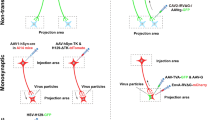The organization of the projections of the lateral nuclei of the midbrain tegmentum (the peripeduncular and perilemniscal nuclei, the nucleus of the brachium of the posterior colliculus) to the functionally diverse nuclei of the basal ganglia system of the brain was studied in dogs (n = 34) using a method based on the retrograde axonal transport of horseradish peroxidase. The study nuclei of the midbrain were found to be involved in functionally diverse circuits whose components include the basal ganglia. These nuclei innervate the area of the putamen, globus pallidus, cuneate nucleus, and subcuneate nucleus, which on the basis of their predominant connections with the motor or limbic nuclei of the brain are classified as motor or limbic nuclei, as well as the area of the caudate and accumbens nuclei and the compact zone of the pedunculopontine nucleus, which receive projections from functionally diverse structures. Analysis of Nissl-stained frontal sections allowed the topographical anatomy of the individual lateral nuclei of the midbrain tegmentum to be refined. Histochemical reactions for NADPH diaphorase was used to determine the cholinergic nature of their neurons.
Similar content being viewed by others
References
O. S. Adrianov, An Atlas of the Dog Brain, Medgiz, Moscow (1959).
A. I. Gorbachevskaya, “Interaction of the pallidum, pedunculopontine nucleus, zona incerta, and deep mesencephalic nuclei – structures of the morphofunctional basal ganglia system,” Morfologiya, 139, No. 3, 19–24 (2011).
A. I. Gorbachevskaya and O. I. Chivileva, “Morphological analysis of information conduction pathways in the basal ganglia in mammals,” Usp. Fiziol. Nauk., 34, No. 2, 46–63 (2003).
P. Arnault and M. Roger, “The connections of the peripeduncular area studied by retrograde and anterograde transport in the rat,” J. Comp. Neurol., 258, No. 3, 463–476 (1987).
A. L. Berman and E. G. Jones, The Thalamus and Basal Telence phalon of the Cat. A Cytoarchitectonic Atlas with Stereotaxic Coordinates, Wisconsin Univ. Press, Madison (1982).
S. Dua-Sharma, K. N. Sharma, and H. L. Jacobs, The Canine Brain in Stereotaxic Coordinates, MIT Press, Cambridge, MA, London (1970).
S. Galati, E. Scarnati, P. Mazzone, and A. Stefani, “Deep brain stimulation promotes excitation and inhibition in subthalamic nucleus in Parkinson’s disease,” Neuroreport, 19, No. 6, 661–666 (2008).
H. H. Jasper and C. A. Ajmone-Marsan, Stereotaxic Atlas of the Diencephalon of the Cat, Nat. Res. Council of Canada, Ottawa (1954).
S. Jbabdi, S. N. Sotiropoulos, and T. E. Behrens, “The topographic connectome,” Curr. Opin. Neurobiol., 23, No. 2, 207–215 (2013).
E. G. Jones, H. Burton, C. B. Saper, and L. W. Swanson, “Midbrain, diencephalic and cortical relationships of the basal nucleus of Meynert and associated structures in primates,” J. Comp. Neurol., 167, No. 4, 385–419 (1976).
R. F. Martin and D. M. Bowden, “A stereotaxic template atlas of the macaque brain for digital imaging and quantitative neuroanatomy,” Neuroimage, 4, 119–150 (1996).
M. M. Mesulam, “Tetramethyl benzidine for horseradish peroxidase neurohistochemistry: a non-carcinogenic blue reaction product with superior sensitivity for visualizing neural afferents and efferents,” J. Histochem. Cytochem., 26, No. 2, 106–117 (1978).
M. M. Mesulam, E. F. Mufson, B. H. Wainer, and A. I. Levey, “Central cholinergic pathways in the rat: An overview based on an alternative nomenclature (Ch1–Ch6),” Neuroscience, 10, No. 4, 1185–1201 (1983).
G. Paxinos and C. Watson, The Rat Brain in Stereotaxic Coordinates, Academic Press, San Diego (1986).
P. Redgrave, N. Vautrelle, and J. N. J. Reynolds, “Functional properties of the basal ganglia’s re-entrant loop architecture: selection and reinforcement,” Neuroscience, 198, No. 1, 138–151 (2011).
A. Sudhyadhom, “Image guidance methods in deep brain stimulation,” PhD dissertation, University of Florida, Gainesville (2010).
S. R. Vincent, K. Satoch, D. M. Armstrong, et al., “NADPH-diaphorase: a selective histochemical marker for the cholinergic neurons of the pontine reticular formation,” Neurosci. Lett., 43, No. 1, 31–36 (1983).
T. Wichman, and M. R. DeLong, “Deep-brain stimulation for basal ganglia disorders,” Basal Ganglia, 1, No. 2, 65–77 (2011).
N. J. Woolf, “Global and serial neurons form a hierarchically arranged interface proposed to underlie memory and cognition,” Neuroscience, 74, No. 3, 625–651 (1996).
Author information
Authors and Affiliations
Corresponding author
Additional information
Translated from Morfologiya, Vol. 148, No. 6, pp. 28–33, November–December, 2015.
Rights and permissions
About this article
Cite this article
Gorbachevskaya, A.I. Organization of the Projections of the Lateral Midbrain Tegmental Nuclei to the Basal Ganglia in the Dog Brain. Neurosci Behav Physi 46, 873–878 (2016). https://doi.org/10.1007/s11055-016-0325-7
Received:
Revised:
Published:
Issue Date:
DOI: https://doi.org/10.1007/s11055-016-0325-7




